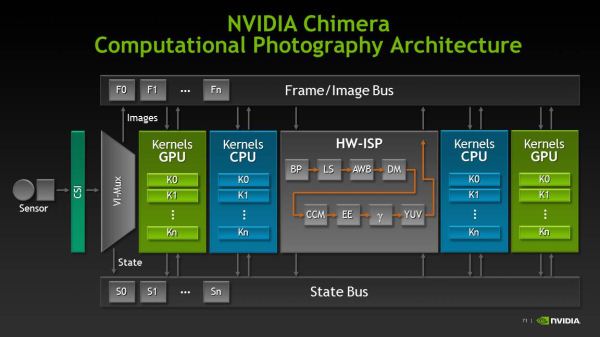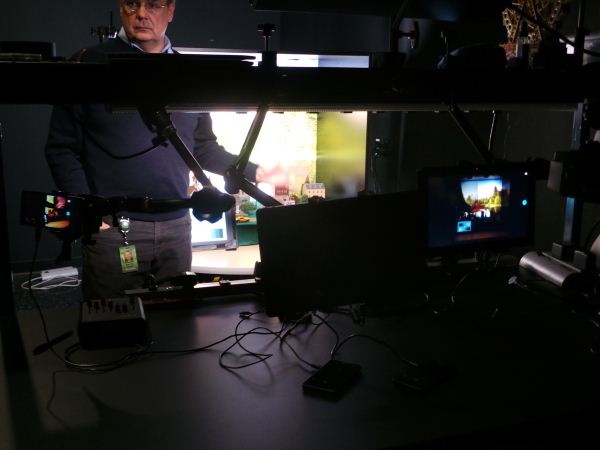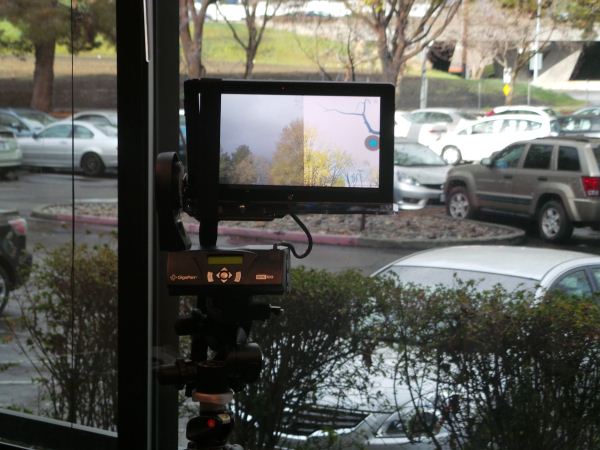NVIDIA Tegra 4 Architecture Deep Dive, Plus Tegra 4i, Icera i500 & Phoenix Hands On
by Anand Lal Shimpi & Brian Klug on February 24, 2013 3:00 PM ESTNVIDIA has upped its ISP game with Tegra 4, and includes the same ISP in both Tegra 4 and 4i, which they’ve dubbed Chimera. This new ISP includes a number of features which were already demonstrated at CES, but NVIDIA went into greater detail.
NVIDIA’s major new feature with Tegra 4 is inclusion of new APIs which leverage the GPU to enable computational camera features In addition to the traditional ISP pipeline. To begin, NVIDIA has made their own enhancements in the imaging chain which leverage this GPU-assisted architecture that sits atop the normal ISP. They’ve outlined a few features which work atop this — HDR panorama, HDR stills, and real time object tracking. The end result is that Chimera is one part programming model and APIs for future development efforts by third parties, another part first party software that NVIDIA will distribute for integration in OEM cameras which includes the HDR features and object tracking.
Chimera allows developers to build blocks around the traditional ISP data flow and get to manipulate either bayer image data or YUV space image data on the CPU or GPU using their own framework. There are still a lot of details to come about the programming model and how this will be exploited, but there clearly is space here for NVIDIA to try and make a case for their GPU being useful for image processing. At the same time, the elephant in the room is OpenCL (and its current absence on Tegra 4) and what direction the industry will take that to leverage GPU compute for some computational photography processing.
The novel new feature of note is something I was skeptical about upon seeing at CES — single frame HDR video. The traditional route for HDR video capture is to capture at twice the framerate of the intended output video, for example for 720p30 video with a two-frame HDR, that would mean capture at 720p60 with two different exposures. What NVIDIA does is a bit different. Instead of capturing two exposures and combining them after capture, NVIDIA has found a way to drive selected CMOS sensors (both IMX135 from Sony and AR0833 from Aptina have been called out specifically, but there are more) in some special fashion, and recombine interleaved high and low exposure images (the +1 stop, –1 stop) image into one equivalent frame. This is all done on the GPU using the same Chimera pipeline blocks, but with NVIDIA’s own algorithm. The results are actually pretty impressive, NVIDIA claims 3 stops of dynamic range (~24 dB), and no recombination artifacts.
Previous demonstrations of HDR video capture on a few other platform have had halos around moving elements because of the issues associated with taking two temporally different frames and recombining them. With NVIDIA’s HDR video capture I saw no halos even on very fast moving objects, with the same quality of HDR.
NVIDIA also demonstrated their panorama capture which includes HDR as well, using a GigaPan Epic 100. Admittedly a better demo might be hand held to demonstrate how well the ISP is able to compensate for change in perspective from the tablet moving around in the hand, the resulting image was the same quality of HDR as the still however. I also saw object tracking which essentially is face tracking (and thus AE / AF assist to that subject) but taken to arbitrary subjects. Paint a box around the object you want to track, and the camera will perform feature extraction and machine learn a model around the object. Rotating around complex geometries seemed to work decently well — the model learns slowly so slow movements can be accommodated, faster moving subjects might not be object tracked.
I also got a chance to tour NVIDIA’s camera tuning labs, where they characterize smartphone CMOSes for handset markers, and work with them on tuning their ISP and imaging experience. I saw one calibration room with many different scenes, and then another room with large test charts, and two sets of standard test scenes in lightboxes. The ever-familiar GMB color checker card and ISO12233 charts were everywhere as well.
















75 Comments
View All Comments
Death666Angel - Wednesday, February 27, 2013 - link
Get a life.StormyParis - Sunday, February 24, 2013 - link
I'd go with Anand, anytime. Charlie is a raving bitch.mayankleoboy1 - Sunday, February 24, 2013 - link
Except that this raving bitch has accurately predicted the future course of most companies months before anybody.Avalon - Monday, February 25, 2013 - link
If by accurate you mean he made many predictions for every company and when one of the predictions came true everyone forgot about all the wrong ones. He guesses.Kiste - Monday, February 25, 2013 - link
Confirmation bias ahoy!AmdInside - Monday, February 25, 2013 - link
Are you kidding me? Even congress lies less than Charlie does.jjj - Sunday, February 24, 2013 - link
I wouldn't expect a huge downclock for phones , they do need to limit heat, not going with POP for the RAM helps ,some actual cooling (air gap or metal) could also be used so they will most likely allow 1-2 cores to go pretty high and maybe all 4 for short periods of time (so the usual tricks to get more out of it).R3MF - Sunday, February 24, 2013 - link
re tegra 4 gpu architecture.how did you get through this many words without mentioning OpenCL?
lack of ES 3.0 is only half the problem.
cmikeh2 - Sunday, February 24, 2013 - link
He does reference it when discussing the Chimera ISP:"At the same time, the elephant in the room is OpenCL (and its current absence on Tegra 4) and what direction the industry will take that to leverage GPU compute for some computational photography processing."
guidryp - Sunday, February 24, 2013 - link
The Icera acquisition was a brilliant one. This gives NVidia the complete mobile package. It will be very interesting to see how this works out in practice. NVidia is a fierce competitor, Qualcomm should be worried.